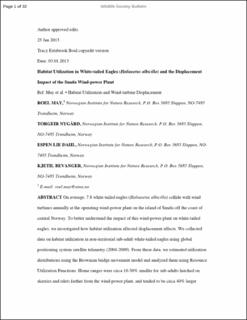| dc.description.abstract | On average, 7.8 white-tailed eagles (Haliaeetus albicilla) collide with wind turbines annually at the operating wind-power plant on the island of Smøla off the coast of central Norway. To better understand the impact of this wind-power plant on white-tailed eagles, we investigated how habitat utilization affected displacement effects. We collected data on habitat utilization in non-territorial subadult white-tailed eagles using global positioning system satellite telemetry (2004–2009). From these data, we estimated utilization distributions using the Brownian bridge movement model and analyzed them using Resource Utilization Functions. Home ranges were circa 10–30% smaller for subadults hatched on skerries and islets farther from the wind-power plant, and tended to be circa 40% larger during spring. Shallow sea, skerries, and islets were utilized extensively, as was marsh, heathland, and forest on the main island of Smøla. We noted lower selectivity for arable land and higher levels of differentiation in utilization among individuals for forest and islets. Females also had a nearly 4 times higher between-individual variation, which was likely due to longranging excursions. The within- and between-individual variation among seasons showed an annual pattern, with increasing between-individual variation toward summer. Displacement (indicated by an overall 40% proportional reduction in utilization) was more pronounced in the birds’ second and third calendar year compared with their first calendar year, and during autumn–winter. Reduced displacement during spring coincides with the white-tailed eagle pre-breeding period with increased flight activity. This may, in part, explain increased collision risk during spring. Possible displacement effects in white-tailed eagles may be avoided by siting wind-power plants farther inland or offshore, avoidance, collision risk, displacement, habitat use, habitat utilization, Haliaeetus albicilla, Norway,wind turbines | en_US |
